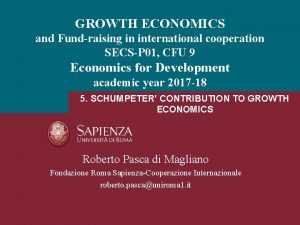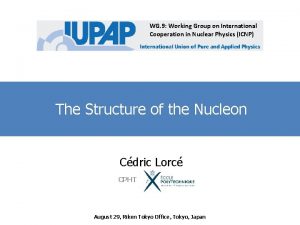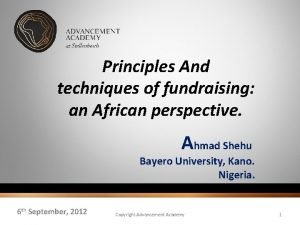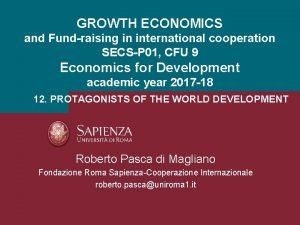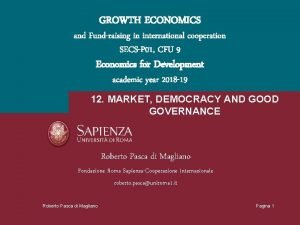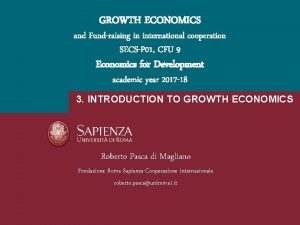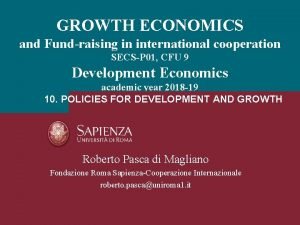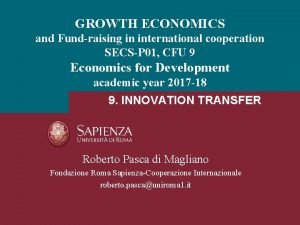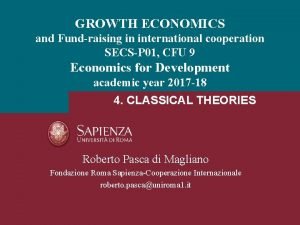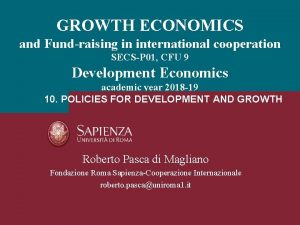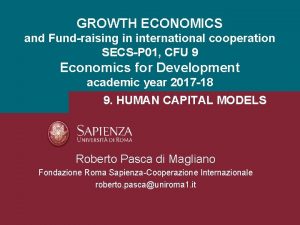GROWTH ECONOMICS and Fundraising in international cooperation SECSP










- Slides: 10

GROWTH ECONOMICS and Fund-raising in international cooperation SECS-P 01, CFU 9 Economics for Development academic year 2017 -18 9. HUMAN CAPITAL MODELS Roberto Pasca di Magliano Fondazione Roma Sapienza-Cooperazione Internazionale roberto. pasca@uniroma 1. it

Human Capital unsolved questions in the Solow model The exogenous growth model of Solow shows a number of unresolved questions as follows: – The growth rate of the economy in the steady state is not explained by the model – The preferences of the population (i. e. the propensity to save) do not affect the growth rate of growth and therefore this rate is insensitive to any economic policy – The hypothesis of convergence between countries predicted by the model doesn’t have empirical evidence Roberto Pasca di Magliano - Human capital Pagina 2

Human Capital introduction • The introduction of the role of the Human Capital in the neoclassical growth model is a possible way out of these difficulties • Models based on human capital as “endogenous growth model” was initially proposed by Uzawa (1965) and later taken over by Lucas (1988) and Romer (1992) • We will better analyze later on the endogenous growth model Roberto Pasca di Magliano - Human capital Pagina 3

Human Capital change in Cobb-Douglas function The typical neo-classical Cobb-Douglas production function would be amended as follows: Y= T* Kα (q. L)β where: • T*: technical progress, exogenously determined • q. L: human capital, in which q represents the changes in production efficiency and its quality It means that by investing in 'education' workers increase their productivity Roberto Pasca di Magliano - Human capital Pagina 4

Human Capital change in Cobb-Douglas It is not sufficient to express the production function as a function of human capital improvements, but it is needed to take account of changes in the age composition of the labor: Δ(q. L)/(q. L) = ΔL/L + δL - δL ΔE • namely, the improvement of the work is given by: Ø the growth of physical units ΔL/L Ø average rate of growth of quality δL Ø the negative effect of changes on the average - δL ΔE Roberto Pasca di Magliano - Human capital Pagina 5

Human Capital Lucas Agents and enterprises can accumulate human capital by transferring part of their working time from production to investment in 'education’ Lucas assumes that the increase in human capital is proportional to both the initial stock of human capital and to the time of labor employed in the production process: ΔH = δH(1 - u) where u is the fraction of time spent working in the production of the final good Y, and δ is a constant Roberto Pasca di Magliano - Human capital Pagina 6

Human Capital stady-state growth rate Under these assumptions the steady-state growth rate of per capita income is as follows: gy = δ (1 - u) It means that the growth rate is equal to the growth rate of the stock of human capital Then, growth rate became 'endogenous' in a double sense: • the growth rate is explained by investments in human capital • the growth rate depends on the choice of allocating labor time to produce work or investing in human capital and it is therefore dependent on the preferences of the agents Roberto Pasca di Magliano - Human capital Pagina 7

Human Capital The issue of convergence between different economic systems The convergence hypothesis was defined by Solow to explain that the growth of both developed and underdeveloped countries will find a similar path in the long run, provided the absence of international restrictions to capital flows The convergence hypothesis is partially confirmed by authors sustaining the determinant role of the human capital on the growth rate such as Mankiew, Romer and Weil (1992) checking for the role of the human capital, by introducing the rate of investment in human capital among the dependent variables of the equation for estimating the per-capita growth rate This result is known as 'conditional convergence’, i. e. different level of human capital in each country, even if combined with a low stock of physical capital, can have a similar positive effect on growth rate. Roberto Pasca di Magliano - Human capital Pagina 8

Human Capital final question Although human capital affects growth rate endogenously, there remains the question of causality between human capital and growth: Does the growth rate of the economy to be influenced by human capital or vice versa? The estimates cross-section used in the literature on convergence hypothesis identify correlations rather than causal relations Roberto Pasca di Magliano - Human capital Pagina 9

Human Capital Policy implications By improving human capital investment in education decision-makers can affect the growth rate of per capita of the economy as: • It improves labor productivity • It attracts capital inflows by compensating for lack of domestic capital accumulation • It improves the use technical progress embodied in the production process Roberto Pasca di Magliano - Human capital Pagina 10
 Secsp
Secsp Fundraising growth platform
Fundraising growth platform International fundraising consultancy
International fundraising consultancy Ilac.mra
Ilac.mra Working group on international cooperation
Working group on international cooperation International laboratory accreditation cooperation
International laboratory accreditation cooperation Principles and techniques of fundraising
Principles and techniques of fundraising Principles and techniques of fundraising
Principles and techniques of fundraising School of business and economics maastricht
School of business and economics maastricht Plant growth index
Plant growth index Eudicot
Eudicot
